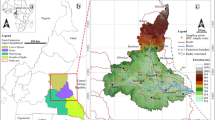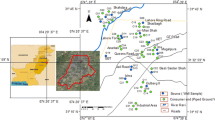Abstract
Drinking water quality assessment is an essential tool to address suitability of drinking water and condition of aquifer environment. This study is aimed to assess the groundwater quality in the Sindh Industrial and Trading Estate (SITE) area of Karachi. We have collected groundwater samples from 24 boring wells, at different depth ranging between 100 and 150 ft., and tested for various physicochemical parameters. We have analyzed the spatially distributed groundwater samples in the under study area by following multi-field assessment (statistical estimation, spatial mapping, and hydrofacies distribution). Water quality is evaluated through physical parameters (pH, electrical conductivity, total dissolved solids, total hardness, turbidity) and chemical parameters, including major ions (sodium, potassium, calcium, magnesium, chloride, sulfate, bicarbonate, nitrate), minor elements (iron, manganese), and trace elements (zinc, nickel, cobalt, chromium, and copper). The concentration of parameters is varying with following range: pH (6.95–7.84), EC (4050–35,600 μS/cm), TDS (2020–17,800 mg/L), TH (890–8100 mg/L), Na (123–930 mg/L), K (10–68 mg/L), Ca (340–8260 mg/L), Mg (176.17–1725.9 mg/L), Cl (1028.05–15,420.75 mg/L), SO4 (122–960 mg/L), HCO3 (1900–5025 mg/L), NO3 (35.52–227.08 mg/L), Fe (41–79 ppb), and Zn (32–1638 ppb). The results of physiochemical parameters were subsequently compared with national and WHO standards. All the sample results were found above the prescribed standards, except the pH level. These parameters were interpolated through ArcMap tools, which showcase the spatial distribution of water quality in the study area and helped us to identify the anomalous water quality parameters. The Piper diagram used to model the ionic relationship and relative concentration of the major cations and anions dissolved in the groundwater samples. The data show the variability among six hydrochemical facies; Ca–HCO3 type (n = 7), Ca–Cl (n = 7), Na–HCO3 (n = 5), Na–Cl (n = 2), Ca–SO4 type (n = 2), and Mg–Cl (n = 1). This baseline study will signify in monitoring groundwater quality of SITE area and provide footnotes to investigate the variability of hydrofacies and diffusion of industrial discharge in hydrological environment of shallow aquifer in the study area.



Similar content being viewed by others
References
Abegunde SM, Akinyele SA, Awonyemi IO (2018) Effect of cassava whey on the physicochemical parameters and heavy metals distribution in soil. Turk J Agric Food Sci Technol 6(9):1196–1199
Adams S, Titus S, Pietersen K, Harris G (2001) Hydro chemical characteristics of aquifers near Sutherland in the Western Karoo, South Africa. J Hydrol 241:91–103
Amin R, Zaidi MB, Bashir S, Khanani R, Nawaz R, Ali S, Khan S (2019) Microbial contamination levels in the drinking water and associated health risk in Karachi, Pakistan. J Water Sanit Hyg Dev 9(2):319–328
Arain MA, Ullah I, Niaz A, Shah N, Shah A, Hussain Z, Tariq M, Afridi HI, Baig JA (2014) Evaluation of water quality parameters in drinking water of district Bannu, Pakistan: multivariate study. Sustain Water Qual Ecol 3–4:114–123
Geng JJ, Wang YP, Luo HJ (2015) Distribution, sources, and fluxes of heavy metals in the Pearl River Delta, South China. Mar Pollut Bull 101:914–921
Gorde SP, Jadhav MV (2013) Assessment of water quality parameters: a review. J Eng Res Appl 3(6):2029–2035
Hem JD (1985) Study and interpretation of the chemical characteristics of natural water, vol 2254. Department of the Interior, US Geological Survey
Kumar P, Kumar M, Ramanathan AL, Tsujimura M (2010) Tracing the factors responsible for arsenic enrichment in groundwater of the middle Gangetic Plain, India: a source identification perspective. Environ Geochem Health 32:129–146
Kumar M, Rahman MM, Ramanathan AL, Naidu R (2016) Arsenic and other elements in drinking water and dietary components from the middle Gangetic plain of Bihar, India: health risk index. Sci Total Environ 539:125–134
McGowan W, Harrison JF (2000) Water processing: residential, commercial, light-industrial. Lisle, IL. Water Quality Association. http://www.eaglewaterquality.com/the-effects-of-hard-water-when-it-comes-to-cooking-and-cleaning/. Accessed 25 Mar 2019
Mrazovac S, Vojinovie-Miloradov M (2011) Correlation of main physicochemical parameters of some groundwater in northern Serbia. J Geochem Explor 108:176–182
Nabi G, Ali M, Khan S, Kumar S (2019) The crisis of water shortage and pollution in Pakistan: risk to public health, biodiversity, and ecosystem. Environ Sci Pollut Res 26:1–3
Naseem S, Bashir E, Ahmed P, Rafique T, Hamza S, Kaleem M (2018) Impact of seawater intrusion on the geochemistry of groundwater of Gwadar District, Balochistan and its appraisal for drinking water quality. Arabian J Sci Eng 43(1):281–293
Nwankwoala HO, Udom GJ (2011) Hydrochemical facies and ionic ratios of groundwater in Port Harcourt, Southern Nigeria. Res J Chem Sci 1:87–101
Pal D, Maiti SK (2018) Heavy metal speciation, leaching and toxicity status of a tropical rain-fed river Damodar. Environ Geochem Health, India. https://doi.org/10.1007/s10653-018-0097-9
Patil VT, Patil PR (2011) Groundwater quality of open wells and tube wells around Amalner town of Jalgaon, district, Maharashtra, India. Electron J Chem 8:53–78
Pulido-Leboeuf P (2004) Seawater intrusion and associated processes in a small coastal complex aquifer (Castell de Ferro, Spain). Appl Geochem 19(10):1517–1527
Radke AG, Godsey SE, Lohse KA, McCorkle E, Perdrial J, Seyfried MS, Holbrook WS (2019) Spatiotemporal heterogeneity of water flowpaths controls dissolved organic carbon sourcing in a snow-dominated, Headwater Catchment. Front Ecol Evol 7:46
Samo SR, Khan A, Channa RSA, Mukwana KC, Hakro AA (2019) Physicochemical and Biological assessment of drinking water quality and its impact on coastal community health of Goth Ibrahim Hyderi, Karachi, Pakistan. Int J Econ Environ Geol 45–50
Şener Ş, Şener E, Davraz A (2017) Evaluation of water quality using water quality index (WQI) method and GIS in Aksu River (SW-Turkey). Sci Total Environ 584–585:131–144
Sultana R, Salahuddin M, Ahmad MN (2018) Economic impact assessment of Brackish Groundwater in Kirana Hills Region, District Chiniot, Pakistan. Int J Econ Environ Geol 9(3):19–24
Tian MJ, Ma XL, Jia J, Qiao Y, Wu TY, Li HX, Liu Y (2016) The exposure level of heavy metals at four different locations near Gan–Ning–Meng reaches of the Yellow River, China. Hum Ecol Risk Assess 22:1620–1635
Venturelli G, Boschetti T, Duchi V (2003) NE-carbonate waters of extreme composition: possible origin and evolution. Geochem J 37:351–366
Wang CH, Hsiao CK, Chen CL, Hsu LI, Chiou HY, Chen SY, Hsueh YM, Wu MM, Chen CJ (2007) A review of the epidemiologic literature on the role of environmental arsenic exposure and cardiovascular diseases. Toxicol Appl Pharmacol 222(3):315–326
Wu ZZ, Che ZW, Wang YS, Dong JD, Wu ML (2015) Identification of surface water quality along the Coast of Sanya, South China Sea. PLoS One. https://doi.org/10.1371/journal.pone.0123515
Xiao J, Jin ZD, Zhang F (2016) Spatial characteristics and controlling factors of chemical weathering of loess in the dry season in the middle Loess Plateau, China. Hydrol Process 30:4855–4869
Yang CX (2006) Chemistry and late Quaternary evolution of ground and surface waters in the area of Yabulai Mountains, western Inner Mongolia. Catena 66:135–144
Yogendra K, Puttaiah ET (2008) determination of water quality index and suitability of urban water body in Shimoga Town, Karnataka. In: The 12th world lake conference, pp 342–346
Zeng XX, Liu YG, You SH, Zeng GM, Tan XF, Hu XJ, Hu X, Huang L, Li F (2015) Spatial distribution, health risk assessment and statistical source identification of the trace elements in surface water from the Xiangjiang River, China. Environ Sci Pollut Res 22:9400–9412
Author information
Authors and Affiliations
Corresponding author
Additional information
Publisher's Note
Springer Nature remains neutral with regard to jurisdictional claims in published maps and institutional affiliations.
Rights and permissions
About this article
Cite this article
Khan, M.J., Shah, B.A. & Nasir, B. Groundwater quality assessment for drinking purpose: a case study from Sindh Industrial Trading Estate, Karachi, Pakistan. Model. Earth Syst. Environ. 6, 263–272 (2020). https://doi.org/10.1007/s40808-019-00676-x
Received:
Accepted:
Published:
Issue Date:
DOI: https://doi.org/10.1007/s40808-019-00676-x




